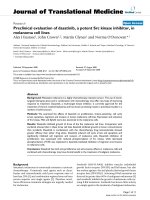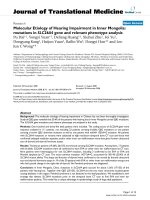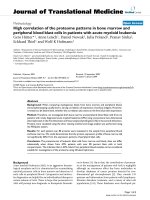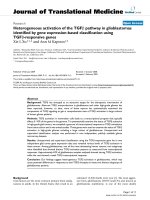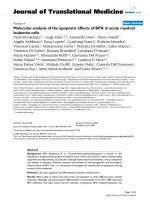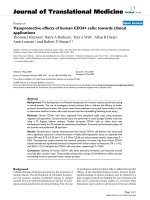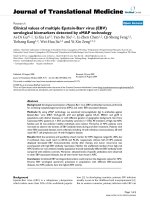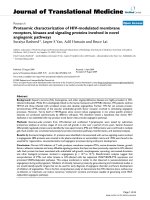báo cáo hóa học: " Retrospective examination of injuries and physical fitness during Federal Bureau of Investigation new agent training" docx
Bạn đang xem bản rút gọn của tài liệu. Xem và tải ngay bản đầy đủ của tài liệu tại đây (344.14 KB, 11 trang )
RESEARCH Open Access
Retrospective examination of injuries and
physical fitness during Federal Bureau of
Investigation new agent training
Joseph J Knapik
1*
, Anita Spiess
1
, David Swedler
2
, Tyson Grier
1
, Keith Hauret
1
, James Yoder
3
and Bruce H Jones
1
Abstract
Background: A retrospective examination was conducted of injuries, physical fitness, and their association among
Federal Bureau of Investigation (FBI) new agent trainees.
Methods: Injuries and activities associated with injuries were obtained from a review of medical records in the
medical clinic that served the new agents. A physical fitness test (PFT) was administered at Weeks 1, 7 and 14 of
the 17-week new agent training course. The PFT consisted of push-ups, sit-ups, pull-ups, a 300-meter sprin t, and a
1.5-mile run. Injury data were available from 2000 to 2008 and fitness data were available from 2004 to early 2009.
Results: During the survey period, 37% of men and 44% of women experienced one or more injuries during the
new agent training course (risk ratio (women/men) = 1.18, 95% confidence interval = 1.07-1.31). The most
common injury diagnoses were musculoskeletal pain (not otherwise specified) (27%), strains (11%), sprains (10%),
contusions (9%), and abrasions/lacerations (9%). Activities associated with injury included defensive tactics training
(48%), physical fitness training (26%), physical fitness testing (6%), and firearms training (6%). Over a 6-year period,
there was little difference in performance of push-ups, sit-ups, pull-ups, or the 300-meter sprint; 1.5-mile run
performance was higher in recent years. Among both men and women, higher injury incidence was associated
with lower performance on any of the physical fitness measure s.
Conclusion: This investigation documented injury diagnoses, activities associated with injury, and changes in
physical fitness, and demonstrated that higher levels of physical fitness were associated with lower injury risk.
Keywords: Overuse, trauma, law enforcement, physical training, gender, 1.5-mile run
Background
The Federal Bureau of Investigation (FBI) is tasked with
upholding and enforcing the criminal laws of the United
States, protecting the United States against terrorist and
foreign intelligence threats, and providing law enforce-
ment and investigative leadershi p and services to federal,
state, municipal, and international agencies and partners
[1]. To accomplish these and other tasks, the FBI Academy
at Quantico, Virginia, trained an average of 700 new
agents each year from 2000 to 2008. During this period,
the new agent course involved about 850 hours of instruc-
tion covering academ ics (such as fundam entals of law,
behavioral science, investigative and intelligence techni-
ques, interviewing, and forensic science), case scenarios,
firearms, operational skills, and other activities.
As in athletics and the military, physical training is an
important part of the FBI new agent training program.
New agents undergo about 90 hours of defensive tactics
training in which agents learn procedures for defending
themselves against physical threats and apprehending
suspects. New agents are expected to maintain a level of
physical fitness that allows them to accomplish the physi-
cal tasks they are expected to perform. They are required
to pass a physical f itness test and t o perform regular
exercise training, either individualized or in groups.
Primarily because of the physical tasks they perform,
new agents will face some risk of injury during their train-
ing program. In April 2008, the FBI Health Programs Unit
* Correspondence:
1
U.S. Army Institute of Public Health, Aberdeen Proving Ground, Maryland,
USA
Full list of author information is available at the end of the article
Knapik et al. Journal of Occupational Medicine and Toxicology 2011, 6:26
/>© 2011 Knapik et al; licensee BioMed Central Ltd. This is an Open Access article distributed under the terms of the Creative Commons
Attribution License ( g/licenses/by/2.0), which perm its unrestricted use, di stribution, and reproduction in
any med ium, provided the original work is properly cited.
requested the assistance of the US Army Institute of Pub-
lic Health (USAIPH) in investigating injuries at the FBI
Academy. The initial concern was a recent outbreak of
exertional rhabdomyolysis, but discussions between the
FBI and USAIPH resulted in a broader goal, which was to
examine all injuries and how physical fitness might be
associated with these injuries; no previous effort had been
made to systematically examine these issues in FBI new
agent training. Thus, t he purpose of the investigation
described here was to report injuries, physical fitness, and
the association of injuries and physical fitness in FBI new
agent trainees.
Methods
This project involved a retrospective examination of inju-
ries and physical fitness among students in FBI new agent
training at the FBI Academy in Quantico, Virginia.
Descriptive information was obtained from available data-
bases and the association between injuries and physical
fitness was examined. The project was reviewed and
approvedasapublichealthpracticeproject[2]bythe
Human Use Review Committee of the FBI, Washington
DC.
Injury Data
All FBI new agents received an initial medical examination
to determine fitness for duty prior to arrival at the FBI
Academy. This included an evaluation of injuries that
might affect their performance during training. While at
the FBI Academy, medical care was provided at the FBI
Health Clinic. Medical care providers at the clinic r outi-
nely entered information on new agent medical encoun-
ters into a database. Medical encounters from 1 Octob er
1999 to 30 September 2008 were examined in this data-
base by trained and experienced personnel who deter-
mined if the encounter was for an injury (defined below)
or for other medical care. For each injury encounter,
extracted information included the date of visit, type of
visit (new injury visit or follow-up on a previous visit),
diagnosis, anatomical location, and activity associated with
the injury. The number of new agents training at the FBI
Academy in the injury survey period was obtained from
the FBI Human Resources Division. Only the total number
of new agents was available and there was no breakdown
by gender.
An injury case was a new agent who sustained physical
damage to the body and sought medical care one or more
times during the survey period. Injuries were grouped by
“type,” which was determined from descriptive informa-
tion in the medical notes and by the specific diagnosis.
Injury types included 1) overuse injury, 2) traumatic injury,
3) any injury, 4) environmental injury and 5) rhabdomyo-
lysis. Overuse injuries were presumably related to long-
term repetitive energy exchanges, resulting in cumulative
microtrauma. Specific overuse diagnoses included stress
fractures, tendonitis, bursitis, fasciitis, muscle injury
presumably due to overuse (strain), joint injury presum-
ably due to overuse (sprain), retropatellar pain syndrome,
impingement, degenerative joint conditions, shin splints,
and musculoskeletal pain (not otherwise specified but with
pain developing over time). A traumatic injury was pre-
sumably due to sudden energy exchanges (acute event),
resulting in abrupt ove rload with tissue damage. Specific
traumatic diagnoses included muscle injury due to acute
event (strain), joint injury due to an acute event (sprain),
dislocation, fracture, blister, abrasion, laceration, con-
tusions, closed head injury/concussion, and pain (not
otherwise specified, but due to an acute event). An envir-
onmental injury was p resumably due to expo sure to
weather, animals, or chemicals, resulting in physical
damage to the body. Environmental and other injury diag-
noses included heat-related injuries, animal bites, chemical
exposures and others. Any injury combined the overuse
and trauma diagnoses as described above, but excluded
environmental/other injuries. The “ any injury” type
included primarily musculoskeletal injuries, b ut also
included dermatological insults (e.g., blisters, abrasions,
lacerations). Because of a special interest in rhabdomyoly-
sis at the FBI academy, rhabomyolysis occurrences were
categorized separately. To be classified as rhabdomyolysis,
the medical record had to have included the diagnosis of
“rhabd omyolys is” or “ possible rhabdomyolysis,” and/or
reported a creatine kinase level exceeding 1,000 U/L.
New injuries were first medical encounters with a new
agent that resulted in a particular injury diagnosis at a
particular anatomical location. Follow-ups w ere subse-
quent medical encounters for the same injury at the
same anatomical location as the new injury (first
encounter). If follow-ups occurred, they were used in
conjunction with the initial encounter to determine the
final diagnosis for a specif ic injury. Thus, an initial diag-
nosis could be changed as a result of a more specific
diagnosis at a higher level of medical care.
Physical Fitness Data
Physical fitness test (PFT) data were obtained from an
existing database in the Physical Training Unit of the FBI
Academy. Every new agent entering the FBI Academy was
required to take and pass the PFT as a graduation require-
ment. PFT s wer e administered within 2 days of arrival at
the Academy (Week 1), at Week 7, and at Week 14 of the
new agent training course. If a new agent passed the Week
1 or Week 7 test, they were not required to take the Week
14 test. PFT data from 31 May 2004 through 1 March
2009 were obtained. The database contained scores on 5
events, total points on the test, and the gender of the new
agent. The P FT consisted of 4 “scored” events: push-ups
to exhaustion (continuous motion), 1-minute b ent-leg
Knapik et al. Journal of Occupational Medicine and Toxicology 2011, 6:26
/>Page 2 of 11
sit-ups, 300-meter sprint, and 1.5-mile run. At least 5 min-
utes of rest were provided between events. Points were
assigned to various levels of performance on each PFT
event (some performance levels result in negative point,
i.e., points < 0). To pass the PFT, a point score of 12 was
required with at least 1 point on each event. Pull-ups to
exhaustion were also tested, but this event was not
included in the FBI’s standard calculation of the total
point score. Details on the PFT and the scoring system
can be found on-line [3].
Data Analysis
Data were compiled and a nalyzed using the Statistical
Package for the Social Sciences (SPSS), version 16.0.1.
Data from the medical records and the PFT database were
combined and a deidentifed database was created. Data
from the PFT database provided gender-specific denomi-
nators for calculating injury rates, and thus injury inci-
dence could be calculated from fiscal year (FY) 2004 to FY
2008 (a FY is from October 1
st
one year to September 30
th
the next year). For all injury types, injury incidences were
calculated as new agent trainees with ≥ 1 injuries divided
by total number of new agents, described as a percentage.
Chi-square statistics were used to compare injury inci-
dences between men and women.
Scores on the Week 1 and Week 7 PFT were compared
using a paired t-test. Average scores for PFT events were
also plotted by FY and linear regression modeling was
used to examine the changes in each event over the years.
The slope of the linear regression equation provided the
least squares estimate of the changes in the average event
scores over the yea rs. The r
2
provided an estimate of the
goodness of fit of the regression equation.
Chi-square statistics, linear trend tests, and logistic
regression were used to examine the associations between
the physical fitness measures and injury incidence. The
dependent variable in the logistic regressions was the pre-
sence or absence of any injury. All fitness events were
entered into the logistic regression models as quartiles
(four approximately equal-sized groups). Simple contrasts
with a baseline variable (defined with an odds ratio of
1.00) were used to describe changes in injury risk across
strata.
Results
There were a total of 6,298 new agents who were
involved in new agent training during the injury survey
period. These new agents experienced a total of 4,616
new injuries with 1,026 follow-ups. Table 1 shows the
number of new injury ca ses and foll ow-ups by diagnosis.
It was not possible to separate the injuries by gender
because the medical records did not contain these data.
Overuse injuries made up 15% of new injury cases, trau-
matic injuries 70%, and environmental/other injuries
15%. The diagnosis with largest number of cases was
musculoskeletal pain associated with trauma. These cases
involved encounters where an individual reported pain in
a specific musculoskeletal location from a traumatic
event, but no specific diagnosis was found in the medical
record. Next in rank order of the number of new cases
were traumatic injuries to muscles (strains) , traumatic
injuries to joints (sprains), contusions, and abrasions/
lacerations. With regard to anatomical locations, the
head accounted for 16% of new injury cases, the u pper
body 42%, and the lower body 37%. The most common
anatomical sites of new injury cases were the knees
(9.9%), shoulders (8.2%), thigh (7.9%), face (6.7%), ankle
(5.7%), chest (5.6%), fingers (5.3%), low back (4.7%), foot
(4.3%), neck (3.8%), shin (3. 6%), elbow (3.1%), hand
(3.1%), calf (2.7%), wrist (2.6%) and head (2.0%).
Table 2 shows the number of injury cases by the
training activity associated with the injury. Almost half
the new injury cases were associated with defensive tac-
tics training and another quarter of the cases were asso-
ciated with physical fitness training. Together, defensive
tactics and physical fitness training accounted for 74%
of activities associated with injury.
Table 3 shows injury incidence by gender and type.
Complete gender-specific denominators were available
only for FY 2004 through early 2009 (from the PFT). Only
data from FY2004 to FY2008 were included in Table 3 so
that 5 complete years of data could be included. Com-
pared to men, women had a significantly higher incidence
of any injury, overuse injury, traumatic injury, environ-
mental injury, and rhabdomyolysis. Gender differences
were much smaller for any injury and tra umatic injury
than for the other injury types.
Table 4 compares the results of the Week 1 and Week 7
PFTs. Week 1 PFT scores were available for 2,837 men
and771women,butTable4containsonlythosewho
took both tests. Only 398 men and 81 women took the
Week 14 test, so these data are not shown. There were sig-
nificant impro vements on all test events from Week 1 to
Week 7. Women improved more than men on both a rela-
tive (%) a nd an absolu te basis for a ll events excl uding
pull-ups.
Figure 1 graphically displays the Week 1 scores for
each PFT event by FY. Figure 1 also shows the linear
regression equations and the r
2
values for each PFT
event. Push-ups, sit-ups and 300-meter sprint scores
showed little change from 2004 to 2009. On the other
hand, the average 1.5-mile run time became progressively
faster over the period. Based on the linear regression
slope, run times were about 4 seconds per year faster or
about 24 seconds faster in FY 2009 compared to FY 2004.
Table 5 shows associations between entry level fitness
(Week 1 PFT) and any injury. Only new agents who had
graduated at the time of the injury data collection were
Knapik et al. Journal of Occupational Medicine and Toxicology 2011, 6:26
/>Page 3 of 11
Table 1 Injury Cases by Type and Diagnoses
Type Diagnosis New Injuries Follow-Ups
Cases (n) Proportion of Total Cases (%) Cases (n) Proportion of Total Cases (%)
Overuse Stress fracture 2 0.0 2 0.2
Tendonitis 79 1.7 36 3.5
Degenerative joint disease 1 0.0 0 0.0
Bursitis 10 0.2 14 1.4
Fasciitis 12 0.3 7 0.7
Retropatellar pain syndrome 22 0.5 11 1.1
Impingement 21 0.5 13 1.3
Muscle injury (overuse strain) 66 1.4 24 2.3
Joint injury (overuse sprain) 18 0.4 5 0.5
Musculoskeletal pain (overuse) 340 7.4 95 9.3
Shin splints 122 2.6 48 4.7
Traumatic Muscle injury (traumatic strain) 520 11.3 175 17.1
Joint injury (traumatic sprain) 437 9.5 146 14.2
Musculoskeletal pain (traumatic) 1250 27.1 159 15.5
Other traumatic injury 20 0.4 4 0.4
Dislocation 46 1.0 24 2.3
Bone Fracture 32 0.7 28 2.7
Tooth Fracture 35 0.8 0 0.0
Nasal Fracture 9 0.2 6 0.6
Blister 30 0.6 2 0.2
Abrasion or laceration 404 8.8 39 3.8
Contusion 428 9.3 78 7.6
Neurological 16 0.3 3 0.3
Closed Head Injury/Concussion 19 0.4 15 1.5
Environmental or Other General heat-related injury 25 0.5 7 0.7
Heat exhaustion 30 0.6 5 0.5
Heat stroke 3 0.1 0 0.0
Rhabdomyolysis 14 0.3 14 1.4
Exertion-related 102 2.2 5 0.5
Dehydration 34 0.7 6 0.6
Insect bites or stings 202 4.4 21 2.0
Other animal bite 2 0.0 0 0.0
Other, environ/toxic injury 2 0.0 1 0.1
Chemical Burn (Capsicum Spray) 244 5.3 27 2.6
Thermal Burn (Shell Casing) 17 0.4 3 0.3
Cold Injury 1 0.0 0 0.0
Unknown 1 0.0 3 0.3
Table 2 Injury Cases by Training Activity
Activity New Injuries Follow-Ups
Cases (n) Proportion of Total Cases (%) Cases (n) Proportion of Total Cases (%)
Defensive Tactics Training 2206 47.8 442 43.1
Physical Fitness Training 1218 26.4 351 34.2
Physical Fitness Testing 262 5.7 63 6.1
Firearms Training 253 5.5 34 3.3
Off-Duty, at Academy 54 1.2 10 1.0
Off Duty, Not at Academy 43 0.9 2 0.2
Operational Skills Training 79 1.7 26 2.5
Sports 31 0.7 3 0.3
Other 54 1.2 3 0.3
Unknown 416 9.0 92 9.0
Knapik et al. Journal of Occupational Medicine and Toxicology 2011, 6:26
/>Page 4 of 11
included so that the entire training period could be
included ( equating time at risk). Pull-ups were not
examined for the women because only 29% of women
had ≥ 1 pull-up recorded. Among men, higher injury
incidence was associated with lower performance on
push-ups, sit-ups, the 300-meter sprint, the 1 .5-mile
run, the total score, and pull-ups. Among women,
higher injury incidence was associated with lower per-
formance on the 1.5-mile run and the total score;
weaker associations were shown between injuries and
push-up, sit-up, and 300-meter sprint performance, but
nonetheless lower performance on these events was still
associated with higher injury risk.
Discussion
The investigation reported here identified common
injury diagnoses, activities associated with injury, com-
parisons of injury incidence rates in men and women,
and t he associations between fitness a nd injuries in FBI
new agent training. Thirty-seven percent of men and
44% of women experienced one or more injuries in
training. Defensive tactics and physi cal fitness training
were associated with 74% of all injuries. A 6-year exami-
nation of temporal trends in physical fitness showed lit-
tle change in push-up, sit-up, or 300-meter sprint
performances, but the average 1.5-mile run performance
did improve. Lower levels of physical fitness were asso-
ciated with higher injury risk.
Injuries
Besides musculoskeletal pain, the largest numbers of
injuries were from strains, sprains, contusions, and abra-
sions/lacerations. These are common injuries in physi-
cally active groups of individuals who are involved in
running, sports, recreational activities, and military
training [4-14]. Only a few cases of more serious trau-
matic injuries such as bone fractures, dislocations, and
subluxations occurred; these totaled less than 2% of all
injuries. In runners and collegiate athletes, fractures,
subluxations, dislocations have accounted for 3% to 13%
of all injuries [4,6,7,9-12]. Less serious injuries like ab ra-
sions/lacerations and contusions each accounted for
about 9% of new agent injuries, which is comparable to
tha t reported in the l iterature: 8% to 11% for abrasions/
lacerations [7,10,12] and 6% to 24% for contusions
[6,9,11,12]. This suggests that compared to other groups
of active individuals, new agent training has a lower pro-
portion of more serious injuries. However, it is possible
that had the musculoskeletal pain (not otherwise speci-
fied) cases been diagnosed at higher levels of medical
care, these may have been added to other diagnostic
categories.
Table 3 Injury Incidence (FY 2004-FY 2008) by Injury Type and Gender
Injury Type Men (% injured) n = 2,555 Women (% injured) n = 693 Risk Ratio-Women/Men (95%CI) p-value
a
Any Injury 37.1 44.0 1.19 (1.08-1.31) < 0.01
Overuse Injury 7.8 12.4 1.58 (1.25-2.01) < 0.01
Traumatic Injury 33.3 38.7 1.16 (1.04-1.30) < 0.01
Environmental Injury 3.2 5.2 1.62 (1.10-2.38) < 0.01
Rhabdomyolysis 0.2 1.0 5.15 (1.64-16.1) < 0.01
a
From chi-square statistic.
Table 4 Entry-Level Physical Fitness and Changes in Physical Fitness from Week 1 to Week 7.
Gender Event N Week 1 Mean ± SD Week 7 Mean ± SD Δ %Δ
a
p-value
b
Men Push-Ups (n) 2,576 37.7 ± 9.4 40.6 ± 8.9 2.9 7.7 < 0.01
Sit-Ups (n) 2,580 45.9 ± 5.4 50.2 ± 4.2 4.3 9.4 < 0.01
300-Meter Sprint (sec) 2,578 46.3 ± 2.6 45.3 ± 2.4 -1.0 2.2 < 0.01
1.5-Mile Run (min) 2,551 11.3 ± 1.0 10.8 ± 0.9 -0.5 4.4 < 0.01
Total Score (points) 2,527 14.6 ± 5.2 18.8 ± 4.9 4.2 28.8 < 0.01
Pull-Ups (n) 2,546 7.7 ± 4.4 8.4 ± 4.5 0.7 9.1 < 0.01
Women Push-Ups (n) 655 19.8 ± 8.9 23.6 ± 7.3 3.8 19.2 < 0.01
Sit-Ups (n) 655 44.5 ± 6.9 49.8 ± 4.2 5.3 11.9 < 0.01
300-Meter Sprint (sec) 654 56.6 ± 3.7 54.9 ± 3.5 -1.7 3.0 < 0.01
1.5-Mile Run (min) 649 12.7 ± 1.2 12.0 ± 0.9 -0.7 5.5 < 0.01
Total Score (points) 645 14.1 ± 5.8 19.5 ± 5.6 5.4 38.3 < 0.01
Pull-Ups (n) 641 0.9 ± 1.9 1.1 ± 2.2 0.2 22.2 < 0.01
a
Calculated as (Week 7-Week 1)/Week 1 × 100%
b
From paired t-test
Knapik et al. Journal of Occupational Medicine and Toxicology 2011, 6:26
/>Page 5 of 11
Among new agent trainees only 15% of injuries were
classified as overuse with 70% classified as traumatic.
With regard to specific injuries, tendonitis accounted for
less than 2% of FBI new agent injuries, but in runners,
college athletes, and military trainees this injury accounts
for 5% to 12% of all injuries [4-6,8,10,13]. In military
basic combat training (BCT) overuse-type injuries
account for about 75% of all injuries [15]. Contrasting
the activity patterns in military training with that of FBI
new agent training might assist in accounting for some of
these differences. In BCT, recruits perform virtually all
physical training as a group, regardless of fitness level.
During running activities individuals of similar fitness
run together [16] but with this single exception: all other
physical and operational training is conducted together,
regardless of fitness level. The basic rationale is to keep
the recruits together to build fitness and operational
competencewhileatthesametimedevelopingmorale
(esprit de corps) and teamwork, all under the guidance of
a knowledgeable leader, the drill sergeant. In contrast,
most FBI new agent trainees performed physical fitness
training on their own. A proportion of new agents who
failed the first PFT were required to attend a group phy-
sical training program three times per week. It is likely
that the individualized physical training performed by
most FBI new agent resulted in fewer overuse injuries
since the intensity, frequency, and duration was deter-
mined by the individual. In contrast to physical fitness
training, defensive tactics instruction was conducted in a
group, with all new agents training together. De fensive
tactics involved boxing, self-defense techniques, and sub-
duing suspects (wrestling, grappling, handcuffing). The
violent nature of these activities likely led to a higher
incidence of traumatic injuries. Another consideration
with regard to distinguishing between overuse and trau-
matic injuries might be workman’s compensation that all
FBI new agents are eligible for. There is some incentive
to link specific injuries to specific causes (rather than
note that the injury had occurred gradually over time)
because workman’ s compensation forms require a
“cause” of injury. T hus, it may be difficult to truly sepa-
rate overuse and traumatic injuries in this population.
In the present investigation, 37% of cases involved the
lower body and 52% involved the upper body. In sports
and recreational activities, the lower body is the site of
over 50% and up to 84% of all injuries [7,11,17,18]. In
military basic training, 77% to 88% of injuries are to the
lower body [13,15], and in military infantry operational
training about 50% to 60% of injuries involve the lower
body [19,20]. Much of military training involves the
lower body in activities like running for physical training
and patrols on foot while carrying equipment (road
Figure 1 Physical Fitness Test Scores by Fiscal Year (FY) from 2004 to 2009. Push-Ups Upper Left, Sit-Ups Upper Right, 300 -Meter Run
Lower Left, 1.5 Mile Run Lower Right. Linear regression equations and squared correlation coefficient are shown for each event.
Knapik et al. Journal of Occupational Medicine and Toxicology 2011, 6:26
/>Page 6 of 11
Table 5 Associations between Physical Fitness and the Incidence of Any Injury
Gender Fitness Variable Strata N Injured (%) p-values from chi-square/trend tests Odds Ratios (95%CI) from Logistic Regression
Men Push-Ups 1-31 repetitions 522 46.6 1.39 (1.10-1.77)
32-37 repetitions 571 37.8 0.01/ 0.97 (0.77-1.23)
38-43 repetitions 590 39.2 0.02 1.03 (0.81-1.30)
44-75 repetitions 595 38.5 1.00
Sit-Ups 0-42 repetition 534 46.8 1.58 (1.23-2.02)
43-46 repetitions 662 35.5 < 0.01/ 0.99 (0.77-1.25)
47-49 repetitions 560 44.3 0.02 1.43 (1.12-1.82)
50-62 repetitions 525 35.8 1.00
300-Meter Sprint 38.2-44.5 seconds 577 36.0 1.00
44.6-46.2 seconds 561 40.5 0.02/ 1.21 (0.95-1.53)
46.3-47.9 seconds 555 39.6 < 0.01 1.17 (0.92-1.48)
48.0-56.6 seconds 588 45.2 1.47 (1.16-1.85)
1.5-Mile Run 7.63-10.70 minutes 569 27.6 1.00
10.71-11.30 minutes 551 31.5 < 0.01/ 1.18 (0.93-1.51)
11.31-11.90 minutes 561 31.5 < 0.01 1.21 (0.95-1.55)
11.91-20.00 minutes 576 42.3 2.01 (1.58-2.54)
Total Physical -4-10 points 522 46.6 1.89 (1.45-2.41)
Fitness Test Score
a
11-14 points 571 37.8 0.01/ 1.07 (0.85-1.33)
15-17 points 590 39.2 0.01 1.07 (0.84-1.36)
18-36 points 595 38.5 1.00
Pull-Ups 0-4 repetitions 592 42.9 1.43 (1.10-1.86)
5-7 repetitions 563 42.1 0.04/ 1.38 (1.06-1.80)
8-11 repetitions 699 39.6 < 0.01 1.25 (0.98-1.61)
12-27 repetitions 406 34.5 1.00
Women Push-Ups 0-13 repetitions 142 52.1 1.51 (0.96-2.35)
14-18 repetitions 128 51.6 0.17/ 1.47 (0.93-2.33)
19-24 repetitions 178 43.8 0.03 1.08 (0.71-1.65)
25-55 repetitions 174 42.0 1.00
Sit-Ups 2-41 repetition 152 52.6 1.45 (0.94-2.24)
42-45 repetitions 162 51.9 < 0.01/ 1.41 (0.92-2.16)
46-48 repetitions 128 38.3 0.05 0.81 (0.51-1.29)
49-59 repetitions 180 43.3 1.00
300-Meter Sprint 45.6-54.4 seconds 161 44.7 1.00
54.5-56.6 seconds 150 46.7 0.19/ 1.08 (0.69-1.69)
56.7-59.2 seconds 157 42.0 0.20 0.90 (0.57-1.40)
59.3-72.5 seconds 154 53.9 1.45 (0.93-2.25)
1.5-Mile Run 9.02-11.92 minutes 159 46.5 1.00
Knapik et al. Journal of Occupational Medicine and Toxicology 2011, 6:26
/>Page 7 of 11
Table 5 Associations between Physical Fitness and the Incidence of Any Injury (Continued)
11.93-12.63 minutes 140 45.0 0.02/ 0.94 (0.60-1.48)
12.64-13.42 minutes 162 39.5 0.19 0.75 (0.48-1.17)
13.43-20.00 minutes 158 56.3 1.53 (1.00-2.24)
Total Physical Fitness Test Score
a
-2-10 points 167 54.5 1.81 (1.17-2.80)
11-14 points 177 48.6 0.04/ 1.43 (0.93-2.19)
15-17 points 118 42.4 < 0.01 1.11 (0.69-1.79)
18-36 points 163 39.9 1.00
a
Negative points are possible in the scoring system
Knapik et al. Journal of Occupational Medicine and Toxicology 2011, 6:26
/>Page 8 of 11
marching), walks to training area, drill and ceremony,
and the like. In contrast, many injuries in FBI new agent
training are associated with defensive tactics which
involved largely the upper body.
From an injury-preve ntion standpoint, the most
important information in the medical records is how the
injury occurred (i.e., activity or cause). Since almost 50%
of injuries were associated with defensive tactics, this is
the obvious focus for injury prevention efforts. Given
the emphasis in the curriculum and the physical invol-
vement, it is reasonable that most of the injuries would
occur in defensive tactics and physical training. We
observed that many safety features were in place at the
FBI academy during defensive tactics training. Examples
are in boxing, the use of boxing gloves, headgear, and
mouthguards. During other defensive tactics training,
agents practiced on cushioned mats, which offered some
protection during falls and takedowns. Nonetheless,
additional efforts to reduce injuries in defensive tactics
should be explored.
Physical Fitness
Over the 6-year period from FY 2004 to FY 2009 there
was virtually no change in the performance of push-ups,
sit-ups, or the 300-meter sprint, but performance on the
1.5-mile run did improve. This is in contrast to studies of
US Army Basic Combat Training and international data
on youth that show declines in running performance
[21-23]. Since 2005, statistical reviews of physical fitness
testing have been provided periodically to FBI field
offices [24]. These reviews noted the number and percent
of new agent trainees who have failed the initial PFT and
compares failures among field offices. Field offices are
charged with assuring that new agent trainees sent to the
FBI Academy are physically prepared, including prepared
to pass the PFT. It is possible that these reports have
called more attention to fitness issues at these field
offices, helping maintain pre-academy push-up, sit-up
and 300-meter sprint performance and improving 1.5-
mile run times.
Associations between Fitness and Injuries
Because of the limitations in defining and separating
overuse and traumatic injuries mentioned above, the
any i njury variable was used to examine the association
between fitness and injuries. The data generally showed
that higher levels of physical fitness were associated
with lower levels of injury. This agrees well with investi-
gations in military basic training [13,15,25-29] and stu-
dies of infantry soldiers [19,20,30]. However, the FBI
new agent data do not agree with most studies of free
living individuals [17,31-36], which generally find that
individuals with higher fitness levels have higher injury
incidence.
One of the common characteristics of military basic
training and FBI new agent training is that individuals
perform many physical activities with their fellow trai-
nees. In the present investigation, about 50% of all activ-
ities were associated with defensive tactics which all new
agent trainees perform together and thus are all exposed
to similar risks. About 25% of injuries were associated
with new agent physical training. New agent trainees
who fail the initial PFT are required to attend supervised
physical training three t imes per week and these new
agent trainees would be performing very similar training.
New agent trainees who pass the initial PFT are allowed
to perform physical training on their own. Nonetheless,
the types of physical training performed by these new
agent trainees was likely similar to that of other new
agent trainees and this training likely involved both
strength and aerobic training and focused on passing the
PFT in Week 7. It is possible that the relationship
between low fitness and higher injury risk can be demon-
strated in military basic training and in new agent train-
ing (but not in civilian groups) because in basic training
and new agent training, the level and type of physical
training are similar among participants.
Law enforcement agencies in the United States and
abroad can benefit from the results of this study by
emphasizing physical fitness in the training of new offi-
cers. This study and previous ones [13,15,25-27,29] have
shown that individuals who arrive fo r training at a higher
level of physical fitness are less likely to be injured. Thus,
individuals should be strongly encouraged to attain a
high level of fitness prior to entry into law enforcement
training. Consideration should also be given to develop-
ing pre-law enforcement training physical training pro-
grams, especially for i ndividuals who display low i nitial
levels of physical fitness. Previous military studies have
shown that such structured fitness-orientated programs
result in lower injury rates once individuals begin boarder
military training [37,38].
Limitations
Injury diagnoses were limited to descriptions in the med-
ical records. Many of these did not involve diagnostic
tests which would have provided more definitive diag-
noses. The largest category of injury was traumatic mus -
culoskeletal pain, which was not more specifically
defined. This category involved encounters where an
individual reported pain in a specific musculoskeletal
location but no more specific diagnosis was found in the
medical record. Thus, the actual incidence of spec ific
diagnoses was very likely underestimated. Nonetheless,
thedataprovidesacomprehensivelookattheavailable
medical visits and shows a high incidence of strains,
sprains, contusions and lacerations which are common
injuries in physically active populations [4-14].
Knapik et al. Journal of Occupational Medicine and Toxicology 2011, 6:26
/>Page 9 of 11
Injury risk was probably slightly underestimated. The
analysis assumes that all agents completed the 17-week
training course, but some new agent trainees did not for
various reasons. Agents who dropped out of training
had less time at risk (i.e., less time exposed to the
hazards of training). To obtain an idea of the size of this
error, we obtained group data (individual data w ere not
available) on the number of new agent traine es who did
not complete the course in FY 2005 through FY 2007.
There was only a 2.9% to 3.8% drop out rate. The effect
of drop outs on the data is likely small.
List of abbreviations
FBI: Federal Bureau of Investigation; USAIPH: United States Army Institute of
Public Health; PFT: Physical Fitness Test; FY: Fiscal year.
Acknowledgements and funding
For the help they provided us on this project and for insights into the
training of new agents, we would like to thank Dr. Thomas Gross, Ms Tanya
Harvin, and Special Agents Timothy Burke, Susann Dreiling, Jay Moeller,
Michael Vough, and Melina Casey. This project was funded by the FBI under
an interagency agreement between the FBI and the US Army Public Health
Command.
Disclaimer
The views, opinions, and/or findings contained in this report are those of
the authors and should not be construed as official Federal Bureau of
Investigation or Department of the Army position, policy or decision, unless
so designated by other official documentation. Approved for public release;
distribution is unlimited.
Author details
1
U.S. Army Institute of Public Health, Aberdeen Proving Ground, Maryland,
USA.
2
Johns Hopkins University, Bloomberg School of Public Health,
Baltimore, MD, USA.
3
Federal Bureau of Investigation, Human Resources
Division, Office of Medical Services, Health Care Programs Unit, Washington,
DC, USA.
Authors’ contributions
JJK was involved in the conception and design, data collection, data
analysis, data interpretation, manuscript writing, and final approval of
manuscript. AS was involved in the data collection, data interpretation, and
final approval of manuscript. DS contributed to the data collection, data
interpretation, and final approval of manuscript. TG was instrumental in the
data collection, data interpretation, and final approval of manuscript. KGH
was involved in the conception and design of the project, data collection,
data interpretation, manuscript writing, and final approval of manuscript. JY
was involved in the conception and design, data interpretation, and final
approval of manuscript. BHJ contributed to the conception and design, data
interpretation, final approval of manuscript
Competing interests
The authors declare that they have no competing interests.
Received: 5 July 2011 Accepted: 9 October 2011
Published: 9 October 2011
References
1. FBI About Us–Quick Facts. [ />2. Hodge JG: An enhanced approach to distinguishing public health
practice and human subjects research. J Law Med Ethics 2005,
Spring:2-19.
3. FBI: FBI New Agent Physical Requirements. [ />asp#1].
4. Brubaker CE, James SL: Injuries to runners. J Sports Med 1974, 2:189-198.
5. James SL, Bates BT, Osternig LR: Injuries to runners. Am J Sports Med 1978,
6:40-50.
6. McLain LG, Reynolds S: Sports injuries in a high school. Pediatrics 1989,
84:446-450.
7. Eisenberg I, Allen WC: Injuries in women’s varsity athletic programs.
Physician Sportsmed 1978, 6:112-120.
8. Knapik JJ, Bauman CL, Jones BH, Harris JM, Vaughan L: Preseason strength
and flexibility imbalances associated with athletic injuries in female
collegiate athletes. Am J Sports Med 1991, 19:76-81.
9. Jackson DS, Furman WK, Berson BL: Patterns of injuries in college athletes:
a retrospective study of injuries sustained in intercollegiate athletics in
two colleges over a two-year period. Mt Sinai J Med 1980, 47:423-426.
10. Lanese RR, Strauss RH, Leizman DJ, Rotondi AM: Injury and disability in
matched men’s and women’s intercollegiate sports. Am J Public Health
1990, 80:1459-1462.
11. Watson AWS: Incidence and nature of sports injuries in Ireland: analysis
of four types of sports. Am J Sports Med 1993, 21:137-143.
12. MacIntosh DL, Skrien T, Shephard RJ: Physical activity and injury. A study
of sports injuries at the University of Toronto, 1951-1968. J Sports Med
Phy Fitness 1972, 12:224-237.
13. Jones BH, Bovee MW, Harris JM, Cowan DN: Intrinsic risk factors for
exercise-related injuries among male and female Army trainees. Am J
Sports Med 1993, 21:705-710.
14. Jones BH, Cowan DN, Tomlinson JP, Robinson JR, Polly DW, Frykman PN:
Epidemiology of injuries associated with physical training among young
men in the Army. Med Sci Sports Exerc 1993, 25:197-203.
15. Knapik JJ, Sharp MA, Canham-Chervak M, Hauret K, Patton JF, Jones BH:
Risk factors for training-related injuries among men and women in Basic
Combat Training. Med Sci Sports Exerc 2001,
33:946-954.
16.
Knapik JJ, Scott SJ, Sharp MA, Hauret KG, Darakjy S, Rieger WR, Palkoska FA,
VanCamp SE, Jones BH: The basis for prescribed ability group run speeds
and distances in US Army Basic Combat Training. Mil Med 2006, 171:669-677.
17. Hootman JM, Macera CA, Ainsworth BE, Martin M, Addy CL, Blair SN:
Association among physical activity level, cardiorespiratory fitness, and
risk of musculoskeletal injury. Am J Epidemiol 2001, 154:251-258.
18. Garrick JG, Gillien DM, Whiteside P: The epidemiology of aerobic dance
injuries. Am J Sports Med 1986, 14:67-72.
19. Knapik JJ, Darakjy S, Jones SB, Marin RE, Hoedebecke EL, Mitchener TA,
Rivera Y, Sharp MA, Grier T, Brown J, Jones BH: Injuries and physical fitness
before and after a deployment by the 10th Mountain Division to
Afghanistan for Operation Enduring Freedom. Aberdeen Proving Ground
MD: US Army Center for Health Promotion and Preventive Medicine
Technical Report No. 12-MA-05SD-07; 2007.
20. Knapik JJ, Ang P, Reynolds K, Jones B: Physical fitness, age and injury
incidence in infantry soldiers. J Occ Med 1993, 35:598-603.
21. Knapik JJ, Sharp MA, Darakjy S, Jones SB, Hauret KG, Jones BH: Temporal
changes in the physical fitness of United States Army recruits. Sports
Med 2006, 36:613-634.
22. Tomkinson GR, Leger LA, Olds TS, Cazorla G: Secular trends in the
performance of children and adolescents (1980-2000). Sports Med 2003,
33:285-300.
23. Santtila M, Kyrolainen H, Vasankari T, Tiainen S, Palvalin K, Hakkinen A,
Hakkinen K: Physical fitness profiles in young Finnish men during the
years 1975-2004. Med Sci Sports Exerc 2006, 38:1990-1994.
24. Moeller JA: Physical fitness statistical review 2005-2009. Quantico Virginia:
Federal Bureau of Investigation Academy Technical Report No; 2008.
25. Jones BH, Bovee MW, Knapik JJ: Associations among body composition,
physical fitness, and injuries in men and women Army trainees. In Body
Composition and Physical Performance. Edited by: Marriott BM, Grumstrup-
Scott J. Washington, D.C.: National Academy Press; 1992:141-173.
26. Shaffer RA, Brodine SK, Almeida SA, Williams KM, Ronaghy S: Use of simple
measures of physical activity to predict stress fractures in young men
undergoing a rigorous physical training program. Am J Epidemiol 1999,
149:236-242.
27. Rauh MJ, Macera CA, Trone DW, Shaffer RA, Brodine SK: Epidemiology of
stress fracture and lower-extremity overuse injuries in female recruits.
Med Sci Sports Exerc 2006, 38:1571-1577.
28. Jones BH, Shaffer RA, Snedecor MR: Injuries treated in outpatient clinics:
surveys and research data. Mil Med 1999, 164(Suppl):6-1 to 6-89.
29. Knapik JJ, Swedler D, Grier T, Hauret KG, Bullock S, Williams K, Darakjy S,
Lester M, Tobler S, Jones BH: Injury reduction effectiveness of selecting
running shoes based on plantar shape. J Strength Cond Res 2009,
23:685-697.
Knapik et al. Journal of Occupational Medicine and Toxicology 2011, 6:26
/>Page 10 of 11
30. Reynolds KL, Heckel HA, Witt CE, Martin JW, Pollard JA, Knapik JJ, Jones BH:
Cigarette smoking, physical fitness, and injuries in infantry soldiers. Am J
Prev Med 1994, 10:145-150.
31. Blair SN, Kohl HW, Goodyear NN: Rates and risks for running and exercise
injuries: studies in three populations. Res Quart Exerc Sports 1987,
58:221-228.
32. Hootman JM, Macera CA, Ainsworth BE, Martin M, Blair SN: Predictors of
lower extremity injury among recreationally active adults. Clin J Sport
Med 2002, 12:99-106.
33. Hootman JM, Macera CA, Ainsworth BE, Addy CL, Martin M, Blair SN:
Epidemiology of musculoskeletal injuries among sedentary and
physically active adults. Med Sci Sports Exerc 2002, 34:838-844.
34. Colbert LH, Hootman JM, Macera CA: Physical activity-related injuries in
walkers and runners in the Aerobics Center Longitudinal Study. Clin J
Sport Med 2000, 10:259-263.
35. Macera CA, Jackson KL, Hagenmaier GW, Kronenfeld JJ, Kohl HW, Blair SN:
Age, physical activity, physical fitness, body composition and incidence
of orthopeadic problems. Res Quart Exerc Sports 1989, 60:225-233.
36. Ready AE, Boreskie SL, Law SA, Russell R: Fitness and lifestyle parameters
fail to predict back injuries in nurses. Can J Appl Physiol 1993, 18:80-90.
37. Lee L, Kumar S, Kok WL, Lim CL: Effects of a pre-training conditioning
programme on basic military training attrition rates. Annals of the
Academy of Medicine (Singapore) 1997, 26:3-7.
38. Knapik JJ, Darakjy S, Hauret KG, Canada S, Scott S, Rieger W, Marin R,
Jones BH: Increasing the physical fitness of low fit recruits before Basic
Combat Training: an evaluation of fitness, injuries and training
outcomes. Mil Med 2006, 171:45-54.
doi:10.1186/1745-6673-6-26
Cite this article as: Knapik et al.: Retrospective examination of injuries
and physical fitness during Federal Bureau of Investigation new agent
training. Journal of Occupational Medicine and Toxicology 2011 6:26.
Submit your next manuscript to BioMed Central
and take full advantage of:
• Convenient online submission
• Thorough peer review
• No space constraints or color figure charges
• Immediate publication on acceptance
• Inclusion in PubMed, CAS, Scopus and Google Scholar
• Research which is freely available for redistribution
Submit your manuscript at
www.biomedcentral.com/submit
Knapik et al. Journal of Occupational Medicine and Toxicology 2011, 6:26
/>Page 11 of 11
